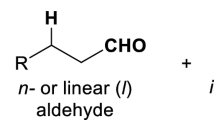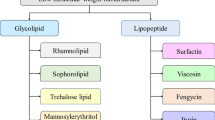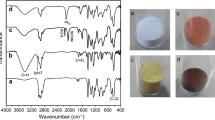Abstract
The photosulfochlorination process has been used in earlier works to produce n-alkane sulfonates. In this work, this process was applied for the first time on lauric and myristic fatty acids, leading to methyl ester sulfonates (MESs). The operating conditions were optimized and the isolation method described. Apart from the known advantages of this reaction, namely the use of sulfuryl chloride, the visible light and short reaction time, this process led to a clear mono-sulfonate products and thus allowed avoiding the bleaching step. The chemical composition of these surfactants was determined and their structures characterized by Fourier transform infrared spectroscopy, liquid chromatography-electrospray ionization tandem mass spectrometry and proton nuclear magnetic resonance. The physicochemical properties of these surfactants such as surface tension, critical micelle concentration, maximum surface excess and minimum area per molecule of surfactant at the air/water interface were determined. The Krafft point was determined experimentally and compared to the MES literature data. The experimental and calculated hydrophilic–lipophilic balance values obtained compared well. The foaming power using Bartsch’s method was presented and the results obtained compared to those of similar structures and those of sodium dodecyl sulfate.







Similar content being viewed by others
References
Holmberg K (2003) Novel surfactants: preparation, applications, and biodegradability. Marcel Dekker, New York, pp 425–466
Schmitt TM (ed) (2001) Analysis of surfactants. Marcel Dekker Inc, New York, p 96
Stepan Company (2010) Stepan China surfactant catalog including food & health specialties
Asinger F (1968) Paraffins chemistry and technology, Pergamon Press, Oxford, UK
Cohen L, Trujillo F (1998) Synthesis, characterization, and surface properties of sulfoxylated methyl esters. J Surfactants Deterg 1:335–341
Cohen L, Roberts DW, Pratesi C (2010) Φ-Sulfo fatty methyl ester sulfonates (Phi-MES). A novel anionic surfactant. Chem Eng Trans 21:1033–1038. doi:10.3303/CET1021173
Zoller U, Broze G, Schick MJ (1999) Handbook of detergents part A: properties. Marcel Dekker, New York, pp 17–18
Azira H, Assasi N, Tazerouti A (2003) Synthesis of long-chain alkanesulfonates by photosulfochlorination using sulfuryl chloride. J Surfactants Deterg 6:55–59
Assassi N, Azira H, Tazerouti A (2006) Recent progress in the manufacture of alkanesulfonates: photosulfochlorination of single chain length (C12–C16) n-alkane using SO2Cl2 at high conversion rates in pure phase and in the presence of solvent. J Surfactants Deterg 9:249–257
Zoller U (2009) Handbook of detergents part F: production. Marcel Dekker, New York, pp 139–156
Nawaz Z, Naveed S (2012) Advances in chemical engineering. Intech. doi:10.5772/2068
Longman GF (1975) The analysis of detergent and detergents products. Wiley, London
ISO 2271 (1972) Surface active agents––detergents––determination of anionic-active matter by manual or mechanical direct two-phase titration procedure
Battaglini G, Larsen-Zobus J, Baker TG (1986) Analytical method for alpha sulfo methyl tallowate. J Am Oil Chem Soc 63:1073–1077
Pocklington WD, Dieffenbacher A (1992) Standard methods for the analysis of oils, fats and derivatives: 1st supplement to the 7th edition. Blackwell Science, Oxford, UK
ISO 712 (2009) Cereals and cereal products––determination of moisture content––reference method
NF ISO 9297 (2000) Water quality––determination of chloride––titration of silver nitrate titration with chromate indicator (Mohr method)
Azira H, Tazerouti A (2007) Micellar behaviour of anionic surfactants with sulfonate function in aqueous solutions. J Surfactants Deterg 10:185–190
Domínguez A, Fernández A, González N, Iglesias E, Montenegro L (1997) Determination of critical micelle concentration of some surfactants by THREE techniques. J Chem Educ 74:1227–1231
Bales BL, Benrraou M, Zana R (2002) Krafft temperature and micelle ionization of aqueous solutions of sodium dodecyl sulfate. J Phys Chem 106:9033–9035
Fekarcha L, Tazerouti A (2012) Surface activities, foam properties, HLB, and Krafft point of some n-alkanesulfonates (C14–C18) with different isomeric distributions. J Surfactants Deterg 15:419–431
Rosen MJ (2004) Surfactants and interfacial phenomena, 3rd edn. John Wiley & Sons, New York, pp 60–64
Saito S, Moroi M, Matuura Y (1982) Dissolution and micellization of sodium n-alkylsulfonates in water. J Colloid Interface Sci 88:278–583
Lunkenheimer K, Malysa K (2003) Simple and generally applicable method of determination and evaluation of foam properties. J Surfactants Deterg 6:69–74
Piispanen PS, Claesson P, Norin T (2004) Surface properties of surfactants derived from natural products. Part 2: structure/property relationships––foaming, dispersion and wetting. J Surfactants Deterg 7:161–167
Myers D (2006) Surfactant science and technology, 3rd edn. John Wiley & Sons, New Jersey
Hovda K (1997) Methyl ester sulfonation: process optimization, proceedings PORIM
Rao YK, Sajic B (1996) Physicochemical properties of some salts of sulfo methyl ester surfactants, Stepan Company, Northfield, pp 383–391
Silverstein RM, Webster FX, Kiemle D (2005) Spectrometric identification of organic compounds, 7th edn. Wiley, New York, pp 96–106
Mayo DW, Miller FA, Hannah RW (2003) Course notes on the interpretation of infrared and raman spectra. John Wiley & Sons, New Jersey
Varka EM, Argyropoulou C, Infante MR, Pegiadou S (2004) Synthesis, characterization, and surface properties of phenylalanine-glycerol ether surfactants. J Surfactants Deterg 7:409–414
Fujiwara M, Nakashima TH, Okano T, Nakamura AA, Sugihara G (1997) Temperature study on critical micellization concentration (CMC), solubility, and degree of counterion binding of α-sulfonatomyristic acid methyl ester in water by electroconductivity measurements. J Colloid Polym Sci 275:474–479
Cohen L, Trujillo F (1999) Performance of sulfoxylated fatty acid methyl esters. J Surfactants Deterg 2:363–365
Salager JL, Choplin L (2008) Mousses, Formation, Formulation et Propriétés, Techniques de l’Ingénieur, vol. Génie des Procédés J2-200, pp 1–14
Acknowledgments
The authors are grateful to Prof. María Rosa Infante, Department of Surfactant Technology, Institute of Advanced Chemistry of Catalonia-Spanich Council for Scientific Research (IQAC-CSIC), Barcelona, Spain, for the helpful discussions and advice concerning NMR measurements.
Author information
Authors and Affiliations
Corresponding author
About this article
Cite this article
Asselah, A., Tazerouti, A. Photosulfochlorination Synthesis and Physicochemical Properties of Methyl Ester Sulfonates Derived from Lauric and Myristic Acids. J Surfact Deterg 17, 1151–1160 (2014). https://doi.org/10.1007/s11743-014-1635-9
Received:
Accepted:
Published:
Issue Date:
DOI: https://doi.org/10.1007/s11743-014-1635-9




